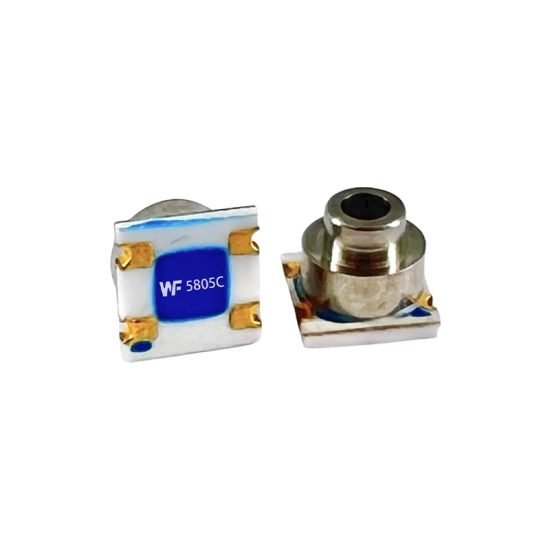Katalog
Hydraulic pressure sensors turn fluid pressure into electrical signals, using MEMS microstructures like diaphragms and piezoresistive bridges for precise readings.
Hydraulic pressure sensors measure pressure directly and can also be used to infer flow, velocity and liquid level. Medical use calls for high accuracy, low drift and fast response.
1. Role and clinical needs
Hydraulic pressure sensors provide real-time pressure monitoring and closed-loop control in medical devices, and they directly affect dosing, breathing cycles and vital-sign alarms. Engineers need to pick the right range and resolution for the device and patient safety needs, and pay attention to long-term stability, temperature effects and response time. That way, if pressure goes beyond limits or jumps suddenly, the system can trigger protections and alarms quickly, avoiding errors that could risk a patient.
Clinical key performance requirements
Key performance factors for hydraulic sensors in medical kit include range matching, resolution, linearity and response time, along with long-term stability and temperature drift. When choosing sensors, focus on the control accuracy you need and make sure the device reliably detects small changes in its normal operating range. Redundant alarm settings and control loops lower single-point failure risk, and quick, traceable logging ensures the system responds fast and remains auditable for safety and compliance.

2. Working principle and MEMS characteristics
Using a diaphragm-based micro-mechanical structure, the sensor turns hydraulic load into strain or capacitance changes; common detectors are piezoresistive bridges, capacitive elements or piezo devices. MEMS processes put tiny strain elements on silicon or metal diaphragms and couple them to bridge circuits, then a low-noise front end, ADC and digital filtering produce a usable output. Packaging must balance fluid compatibility, leak prevention and biocompatibility to meet medical-grade reliability over time.
MEMS sensing elements and signal formation
MEMS hydraulic sensors convert diaphragm strain, capacitance shifts or piezo effects into electrical quantities, which a low-noise front end and ADC then turn into usable signals. Packaging must ensure fluid and biological compatibility and prevent bubbles, leaks and mechanical stress from skewing readings. Design should optimise bridge balance, filter bandwidth and differential measurement to keep noise and drift down while maintaining response speed, ensuring stable and repeatable clinical measurements.
3. Key performance metrics and calibration requirements
When selecting sensors, check range, resolution, linearity, hysteresis, sampling rate and temperature drift. Medical devices demand high resolution and stability. Calibration covers zero and span calibration, fitting temperature compensation curves and verifying frequency response. Proper signal conditioning includes bridge balancing, differential amplification and digital correction algorithms. Regular checks and records keep readings consistent and traceable across environments and over long service life.
Calibration process and temperature compensation points
Solid calibration includes zero and full-scale checks, layered temperature corrections and frequency-response verification. Gather calibration data on a controlled temperature rig and fit compensation curves stored in the sensor or controller for real-time temperature compensation. For high-accuracy devices, run multi-point verification and error logging to build traceable calibration records, so maintenance and troubleshooting can pinpoint the source of deviations.
4. Common fault analysis and troubleshooting
Inaccurate or unstable readings usually come from sensor ageing, contaminated contact surfaces, poor cable connections or incorrect mounting. If readings jump, check vibration protection and cable joints; if readings are consistently low or high, recalibrate and confirm installation orientation and fluid damping. Engineering processes should include mechanical interface checks, signal-chain integrity tests and closed-loop comparisons with known pressure points to quickly find and fix the issue.
Fault diagnosis flow and quick checks
On abnormal readings, check mechanical interfaces, seals and fluid contact first, then verify cable, connector and signal-chain integrity, and compare with known reference pressures. If you see jumps or increased noise, inspect for vibration, shocks and electromagnetic interference. For systematic offsets, prioritise recalibration or replacement of aged components. A standardised checklist speeds up diagnosis and reduces downtime so clinical devices get back to a compliant state quickly.
5. System integration and design points
When integrating at device level, consider the sensor together with control algorithms, power and filtering so sampling rate and filter bandwidth meet both response speed and noise suppression needs. Mechanical mounting must avoid stress concentrations, keep the correct fluid contact area, and include anti-vibration, EMI and moisture protection. Final validation should cover static and dynamic loading, immunity tests and long-term drift assessment to ensure consistency and maintainability in clinical use.
Integration testing and validation standards
Device-level validation should include static accuracy, dynamic response, interference immunity and long-term drift testing. Tests must cover typical physiological conditions and extreme events, and log every measurement point for traceability. During integration, check sampling rate, filter delay and closed-loop matching so the sensor and control algorithms together meet safety thresholds and alarm timing. These validation steps are key to ensuring safe clinical use.
Závěr
Hydraulic pressure sensors play a central role in measurement and safety protection within medical equipment. By understanding MEMS operation, controlling performance metrics closely and applying systematic calibration and fault-finding, We can ensure devices give accurate readings, respond quickly and run reliably — protecting patients and supporting correct clinical action.
Výše uvedený úvod pouze poškrábe povrch aplikací technologie tlakových senzorů. Budeme pokračovat ve zkoumání různých typů senzorových prvků používaných v různých produktech, jejich fungování a jejich výhod a nevýhod. Pokud byste chtěli více podrobností o tom, o čem se zde diskutuje, můžete se podívat na související obsah později v této příručce. Pokud vás tlačí čas, můžete také kliknout sem a stáhnout si podrobnosti o těchto příručkách Data produktu PDF na tlak vzduchu.
Pro více informací o dalších senzorových technologiích prosím Navštivte naši stránku Sensors.
